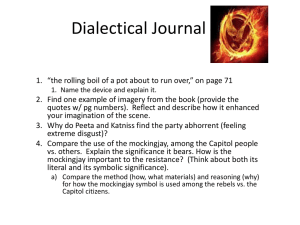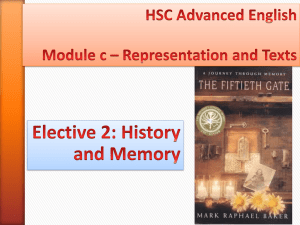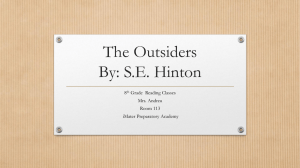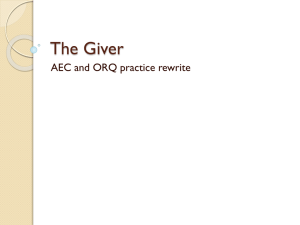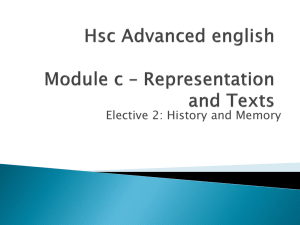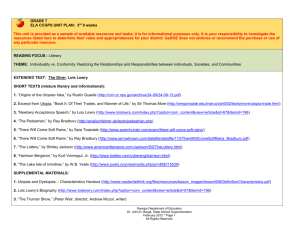Citing Textual Evidence
advertisement
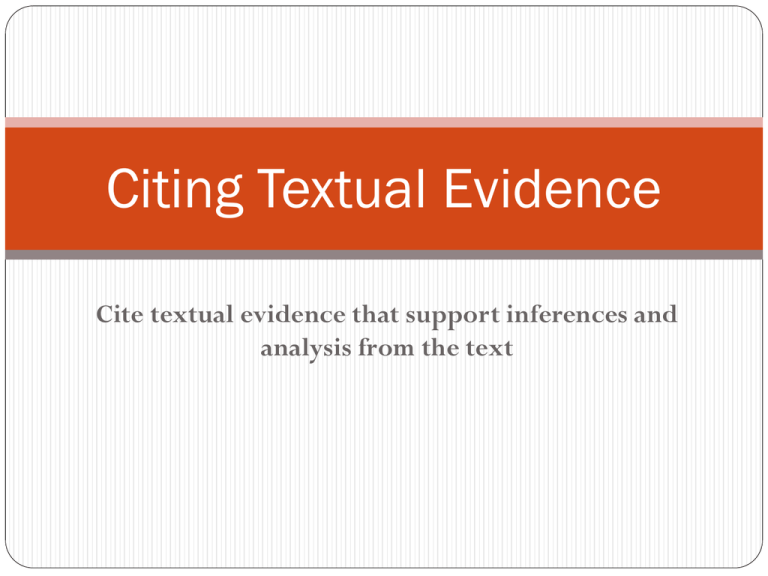
Citing Textual Evidence Cite textual evidence that support inferences and analysis from the text Explicit Textual Evidence When we have ideas about what we read, we need to cite Explicit Textual Evidence to support our ideas. When we read, we often are asked to answer questions or express our ideas about the text. In order to let people know we aren’t “making stuff up”, we should use Explicit Textual Evidence to support our opinions or answers. In real life, people who can back up an opinion about a text with Explicit Textual Evidence are taken more seriously than people who can only give a reason of “just because.” Explicit Textual Evidence What does Explicit Textual Evidence mean? The name really says it all. Explicit = direct Textual = from the text Evidence = support for your answer, opinion, or idea Explicit Textual Evidence Giving Explicit Textual Evidence about your answers or opinions regarding a text is pretty simple.You just have to do three things: 1. 2. State your idea: State the idea you had about the text (if you are responding to a specific question, be sure your idea restates the question). Cite what in the text led you to that idea: Give supporting evidence from the text by directly quoting or paraphrasing from the text. If you are directly quoting from a text, you must use quotation marks. Begin with sentence starters = In the first paragraph, the author says…, On page ___, the author states…., The text states…,The text describes…, For example…,The author explains…, Early in the text, the author…., For instance…, According to the text… 3. Explain the Evidence: Explain how the quote(s) you pointed out support your idea, opinion, or answer . In other words your explanation should describe your interpretation of the evidence. It might tell the reader what the author of the text means or how the textual evidence proves your topic sentence (stated idea). Begin with sentence starters = This shows...This is because...This means...This reveals...This illustrates...This highlights...This proves…This exemplifies… In the book The Giver by Lois Lowry, chapter nine begins “Now for the first time in his twelve years of life, Jonas felt separate, different.” This occurred because Jonas was being treated differently by others, and he felt separate because he would be alone for the rest of his life. First, everyone felt differently about him because he was more important which led to different treatment at the end of the ceremony. On page 65 it says, “People moved aside for him. They watched him. He thought he could hear whispers.” Now that he was selected to be the next Receiver of Memory, others cleared the way for him as he walked by them. Also, the whispers could be about how he was very important, and the comments made him feel self-conscious. This shows that almost immediately others treated him differently and therefore, he felt separate. Model Answer Question: Chapter nine begins, “Now for the first time in his twelve years of life, Jonas felt separate, different.” Explain the meaning of this quote. How are others treating him? Why might Jonas feel separate and different after his selection? Here, the writer restates the question and answers it with an idea about the text. Here, the writer includes a direct quote from the text as evidence. Here, the writer comments on how the quoted text that was cited as evidence helped form the idea that was stated to answer the question. In addition, Jonas will be alone with the current Receiver while he trains. On page 69 it states, “Jonas was stunned. What would happen to his friendships? His mindless hours of playing ball or riding his bike along the river? Those had been happy and useful times for him. Were they to be completely taken from him, now?” While everyone else is able to play and enjoy physical activity, Jonas must work and train hard for his selection. This reveals that with no free time or interaction during his training, Jonas will be confined to just train to become the Receiver of Memory. Eventually, being alone will separate him from society. Here, the writer provides an additional answer to the question with an idea about the text. Here, the writer directly quotes from the text to give a second piece of evidence. Here, the writer comments on how the quoted text helped form the idea that was stated to answer the question. Modeling/Guided Practice Question: Why does Jonas feel uneasy with his selection, even when the Chief Elder states, “He has shown all of the qualities that a Receiver must have”? Use details from the text to support your answer. As a class, we are going to use the three steps for citing textual evidence. State, Cite, Explain Write down the question. State the idea you had about the text (if you are responding to a specific question, be sure your idea restates the question). Modeling/Guided Practice QUESTION STATE CITE EXPLAIN Your Turn! Directions: Complete the Independent Practice graphic organizer using the question below. Turn in upon completion. Question: How do Jonas’s father’s actions impact Gabriel’s situation in Chapter 6? Use details from the text to support your answer.


